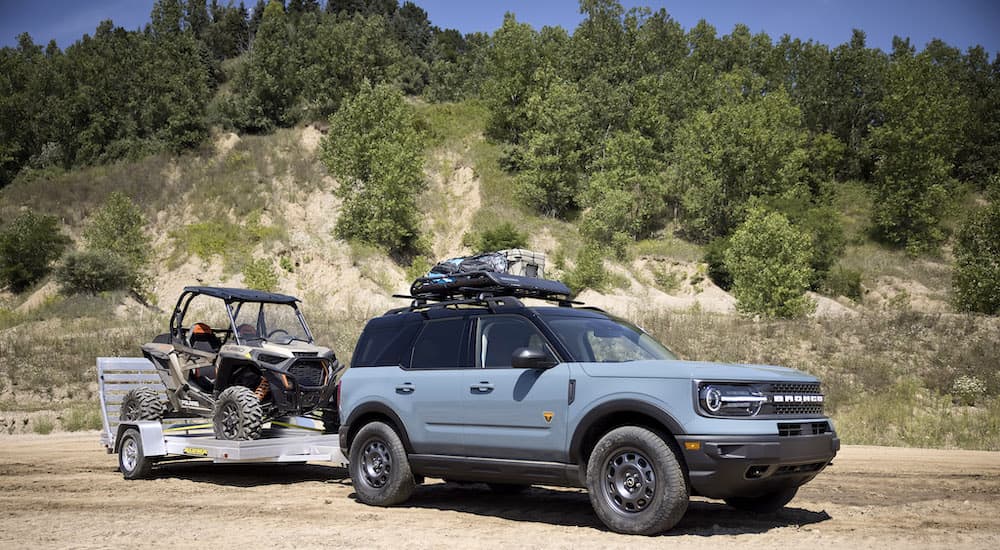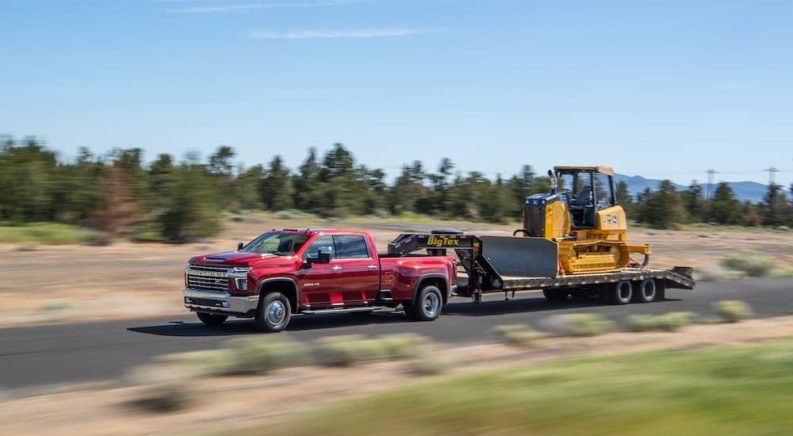Towing can be a difficult and even dangerous activity for the unprepared driver. Unfortunately, most drivers never have the opportunity to learn the intricacies of towing and become comfortable with the activity. Instead, they often find themselves with a trailer they need to tow and stumble through the process. By the time they reach their destination, they are usually ready to swear off towing altogether. However, with a little preparation and a better understanding of the process, you can soon be towing like a pro. While we can’t give you the skills to start maneuvering larger trailers through tight streets like a natural, we can give you a quick overview of what you need to know to keep your vehicle and yourself in one piece the first time you head out on the road with a trailer in tow.
Get Comfortable with Numbers
The first rule of safe towing is to never just assume that your vehicle can handle a given trailer. Tow ratings, tongue weights, gross combined weight ratings, and more can make your head spin, but all those numbers exist for a reason, and that reason is to keep you safe and in control of your load. While a vehicle certainly can tow more than its tow rating would indicate, that doesn’t mean it should. You’re not going to instantly destroy your vehicle by overloading it by a couple of hundred pounds, but you will be shortening its life and putting yourself in some potentially dangerous situations. The truth behind official tow ratings is that they are less about how much the frame can handle and more about how much the suspension, brakes, and engine cooling can handle. While overloading those aspects of your vehicle may not be immediately obvious, it will be setting yourself up for trouble, so keep things under the limits.
For the more casual tower, there are two main numbers you will want to keep in mind: your vehicle’s tow rating and its payload rating. The tow rating is obvious, but many drivers never think about the payload rating. A properly loaded trailer should have its center of gravity slightly ahead of its axles, putting a downward force on your vehicle’s hitch. That force (the tongue weight) is generally around 10% of the trailer’s total weight and needs to be figured into your total payload. Otherwise, you run the risk of overloading your suspension and compromising your vehicle’s handling. Depending on how heavily the vehicle is loaded with passengers and cargo, you may well run out of payload long before you hit its theoretical tow limit.
Know the Actual Limits of Your Equipment
The theoretical towing capacity of your vehicle is just that–theoretical. How much weight you can actually tow will depend heavily on what sort of towing equipment you are using. While you may be familiar with the heavy-duty gooseneck and fifth-wheel hitches, you might be surprised to learn that there is also a huge variety of different ball hitches. So just because you have a hitch on your vehicle does not mean that you should assume it can handle the maximum towing capacity printed on the door jamb sticker. Your “standard” bumper hitch can fall into five different categories, each rated for a different level of weight, so double-check that your hitch can handle your trailer before you start towing in order to keep from overloading your vehicle.
Class 1: 2,000 lbs
Class 2: 3,500 lbs
Class 3: 8,000 lbs
Class 4: 10,000 lbs
Class 5: 20,000 lbs
Before going further, note that these are only the maximum limits for each class. It is perfectly possible to have a Class 3 hitch that is rated for far less than 8,000 lbs, so look up your individual hitch if possible. Class 1 and 2 hitches are generally found on cars and smaller crossovers and use a 1¼-inch receiver. Class 3 and 4 hitches are your standard truck hitches and use a 2-inch receiver. They can also be found on some larger SUVs. Class 5 hitches are generally only found on heavy-duty trucks and commercial vehicles, and so we will be putting them aside along with gooseneck and fifth-wheel hitches. If you are new to trailering, you should probably think twice before hitching up a trailer that weighs over five tons.
There is also a bit of an asterisk on those numbers. A Class 3 or Class 4 hitch can actually tow up to 12,000 lbs or even more if you are using a weight-distribution hitch. This is a special type of hitch that includes two bars extending out from the bumper to help control the trailer. Even if you don’t need that extra capacity, you should be using a weight-distribution hitch for any trailer that weighs over 5,000 lbs. Not only will it make for a far more confident trailering experience, but it is also recommended by all manufacturers and may even be legally required in some locations.

Towing Takes More Than a Hitch
So far, things have been pretty straightforward. Not towing more weight than your equipment is rated to handle is a fairly obvious recommendation, even if far too many drivers ignore it. However, there are still some other factors that need to be considered, particularly lights and brakes. In order to tow safely and legally, you need to have taillights, brake lights, and turn signals. These are commonly powered by a 4-pin or 7-pin electrical connector. If you are adding a hitch to your vehicle, make sure that you also add the connector needed for your trailer, and every time you hitch up, take a moment to make sure that all your lights are working. A 4-pin connector will power all the basic lights, but a 7-pin connector will also add power for reverse lights, auxiliary systems, and most importantly, trailer brakes.
Adding weight to a vehicle puts more stress on the brakes and results in a longer stopping distance. Add too much weight, and you will no longer be able to rely on the brakes in an emergency. This is why any trailer that weighs over 3,000 lbs should always be fitted with trailer brakes. Not only will the trailer brakes give you more stopping power when needed, but they will also help stabilize the trailer under heavy braking, vastly improving safety on the road. In most areas, there is a legal requirement for brakes on trailers above a certain weight, so make sure to double-check the local laws anywhere you will be driving. But even if the local limit is over 3,000 lbs, we recommend sticking to that figure to keep things safe and reduce the stress on your vehicle.
Safe Towing on the Road
Once you have your vehicle and trailer ready, there are a few more towing tips to keep you safe on the road. The single most important tip is to always connect your trailer to your vehicle with a pair of chains as well as the hitch. Hitches do fail, and a loose trailer on the road can be deadly to anyone behind you. The chains give you an extra level of safety, allowing you to pull over and re-hitch if anything goes wrong. When you use chains, make sure that each individual chain is strong enough to secure the chain, always connect them in an “X” pattern, and keep them just long enough not to bind in turns. Also, make sure the chains are connected to something sturdy on both ends–the last thing you want is for a loose trailer to pull your bumper off as it goes spinning across the road.
Another important tip is to learn how to downshift for steep hills. If you know how to drive a manual or live in a particularly hilly area, this will likely be second nature, but most drivers will ride their brakes when going downhill. Add in the extra weight of the trailer, and this can quickly result in overheating your brakes. Even if you never experience a sudden lack of stopping power, riding your brakes will result in much more frequent brake maintenance on your vehicle. Most modern automatic transmissions will have some sort of manual mode that will let you lock out the top gears and rely on engine braking to keep your vehicle and trailer descending at a controlled speed. Many trucks and some larger SUVs will even come with a “Tow/Haul” mode that will downshift automatically when the vehicle senses a steep incline. Using these modes is important for safe towing in hilly areas and will keep you from ever needing to use a runaway truck ramp.

Preparation Is the Secret to Confident Trailering
While many drivers dread having to hook up a trailer, proper preparation will turn towing into just another drive. There are a lot of little details to remember, so we recommend finding yourself a checklist to run through every time you hit the road with a trailer in tow. Some manufacturers even include a digital towing checklist in their trucks’ infotainment systems. Knowing that you have done everything possible for a safe towing experience will let you focus on driving and learning how to maneuver your trailer in all conditions. It may take you a while to become fully confident with a trailer in tow, but starting with a good foundation will have you trailering like a pro in no time and keep you from ruining your vehicle as you learn.

